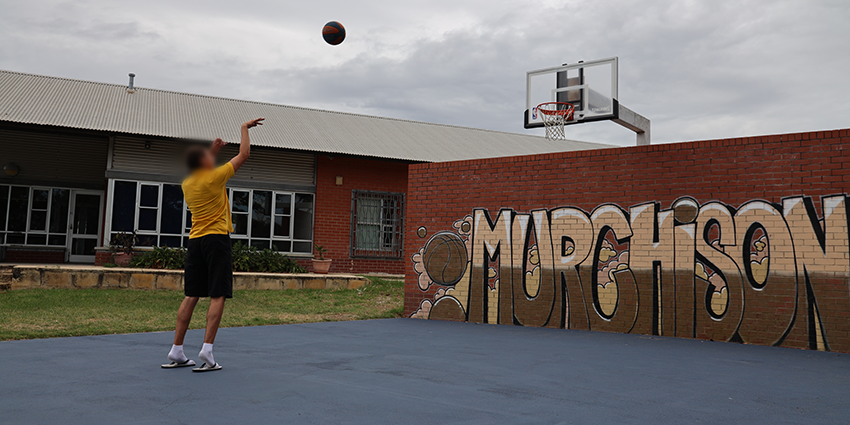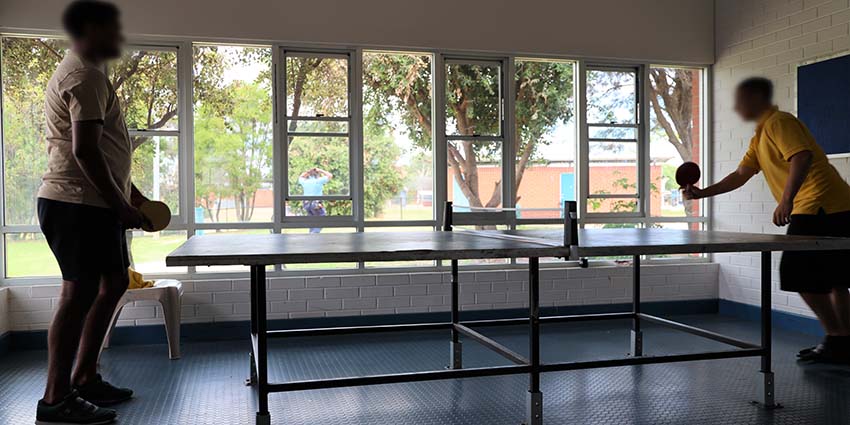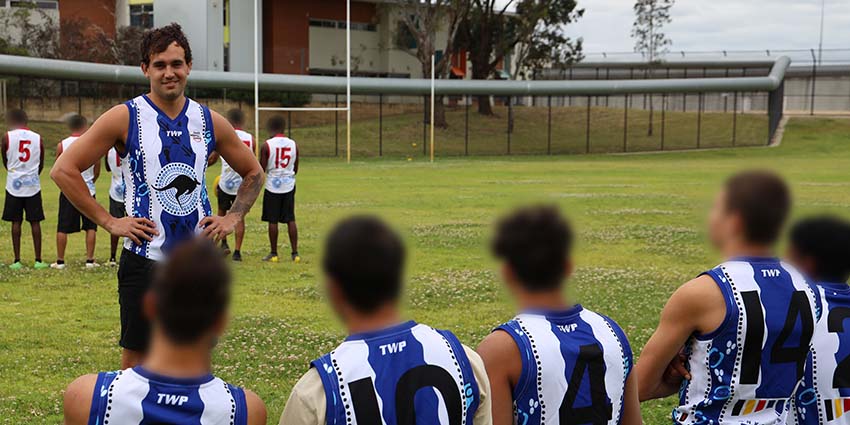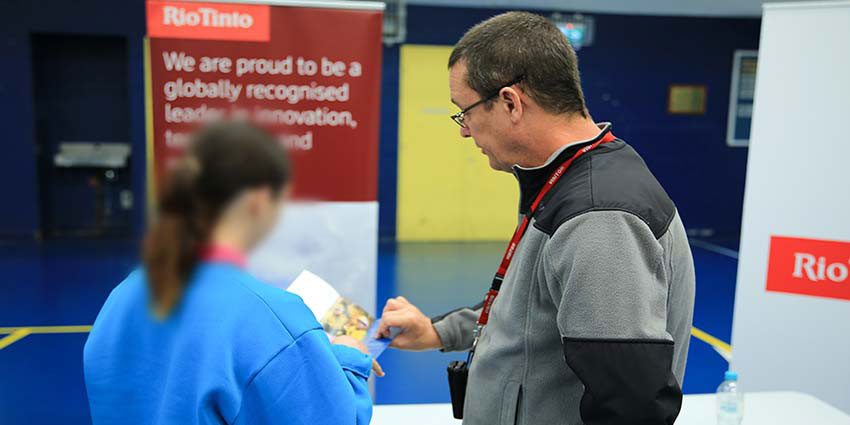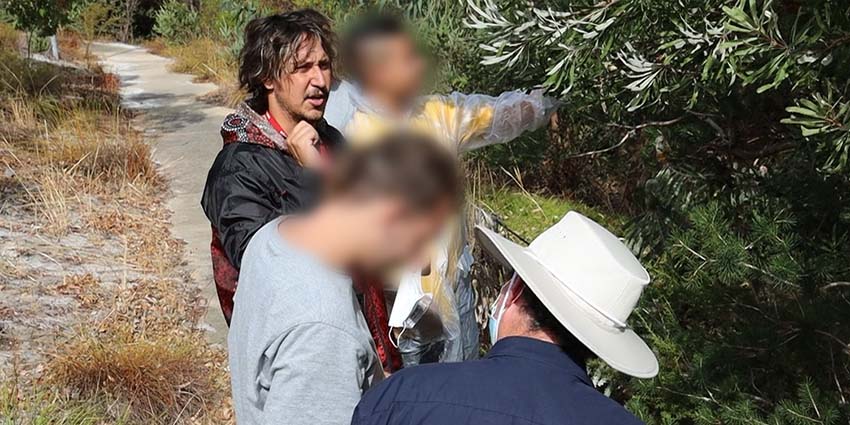
Detainees participate in an Aboriginal Ranger Program introductory course at Banksia Hill.
Normal operations at the Centre have been difficult to maintain in recent months for a variety of reasons, including the impact of COVID-19.
The Centre manages a complex cohort of young people, some of whom present with significant cognitive and behavioural challenges.
These detainees have been involved in frequent incidents including damaging infrastructure, climbing fences and roofs, assaulting staff and self-harming, including making serious self-harm attempts.
The management of these critical incidents and the need to ensure a safe and secure environment for detainees and staff led to greater numbers of young people being housed in the Centre’s Intensive Support Unit and increased the frequency of lockdowns.
By February 2022 the situation had improved, with the numbers of critical incidents and self-harm events decreasing substantially.
A reinvigorated program of enrichment activities and education is underway and approximately 40 Youth Custodial Officer recruits have joined in the Centre over March and April. Further recruitment is underway with additional initial training courses planned for May, June and September.
“In recent months we've had young people who were hurting themselves, hurting staff and causing a lot of damage to the facility,” Department of Justice Director General Dr Adam Tomison says.
“Managing the Centre with this cohort of young people and ensuring strategies to keep both the young people and staff safe required a more restrictive regime than was desirable and which was not in line with our aspirations for the Centre,” he says.
“Our aim is to provide an environment where the needs of the young people are met and they are supported to make positive changes to their lives,” Dr Tomison says.
“A number of measures have been taken and reforms are under way to bring long-term benefits for the young people in our care.
“Those strategies, increased staffing and new enrichment activities are starting to turn things around and it’s pleasing to see the young people regularly attending education classes, taking part in programs and playing sport.”
Reforms
Changes and upgrades at Banksia Hill have been underway since 2021 and reforms in the works aim to adopt best practice to the centre.
Remedial infrastructure works and upgrades have commenced. Observation cells in the ISU have been refurbished.
The State Government has committed $25.2 million towards upgrading infrastructure and services at Banksia Hill. That includes building a $7.5 million Crisis Care Centre to provide a safe and therapeutic environment for vulnerable, at-risk young people.
Education technology and resources will be updated and extra staff funded for an Aboriginal Services Unit created to provide specific cultural supports and services.
The Department is developing a new operating philosophy and service model that will better enable the delivery of services to young people using trauma-informed principles in line with child safe practices. That model includes:
- New or refined assessment and intervention frameworks
- A redeveloped therapeutic culture that supports positive behaviour management
- Individualised case planning
- Promoting cultural responsivity
Under this service model, well-trained, adequately resourced staff would address the unique needs of different cohorts and endeavour to provide young people as much autonomy and normality as possible within the parameters of maintaining a secure facility.
“We’ve been working on a range of measures with staff and senior executives in the Department for some months now,” Dr Tomison says.
“We have got a lot more work to do with the aim of maintaining high standards and keeping our system as therapeutic and rehabilitation-focused as possible.”
By the numbers
The average daily population of young people detained at Banksia Hill in the past calendar year was 108.
While dedicated staff and external service providers work hard to educate, and rehabilitate young people at Banksia Hill, it should be noted that most of them are not detained for long periods of time.
The average length of stay in recent years is 37 days.
About 90 per cent of those in detention are on remand. They are either awaiting a bail or sentencing decision by a court.
More than half of young people on remand stay for less than a week. Over 90 per cent of them will stay for less than a month; only 2 per cent will stay for more than three months.
The remaining 10 per cent of detainees are serving custodial sentences. Nearly a third of sentenced young people will be released in less than three months and more than two-thirds will be released in less than six months.
Between 35 and 40 per cent of first-time entrants do not return to Banksia Hill.
Who are the detainees
The large majority of young people in detention come from disadvantaged backgrounds. More than 70 per cent are Aboriginal.
About 90 per cent are boys. About 40 per cent are from regional WA.
Many detainees live with severe neurodevelopmental impairment (nearly 90 per cent). The three most diagnosed conditions include; Fetal Alcohol Syndrome Disorder (about 60 per cent), Language Disorder (about 50 per cent), and Attention Deficit Hyperactivity Disorder (nearly 40 per cent) as well as other cognitive impairments or mental health issues, or a combination.
About 20 per cent are under the care of the CEO of the Department of Communities.
Few of them are first offenders. Many will have served court orders in the community or been detained for previous offences.
The Department’s Youth Justice Services (YJS) works with young people to reduce youth re-offending. YJS delivers a range of support and interventions that divert young people away from the criminal justice system. Prevention programs offer opportunities for change and rehabilitation.
“These aren’t the average kids on the block,” Dr Tomison says. “Detention is a last resort under our legal system and for these young people there are a number of reasons that have led them on this pathway.”
Daily life
Banksia Hill has regular routines for young people. They usually go to classes at the facility’s education centre during school terms and are provided a variety of other enrichment activities, programs, services, and supports. This includes Aboriginal Welfare Officers, the Aboriginal Visitors Scheme and Aboriginal Education Officers.
Young people have access to telephone calls, social and official visits, and take part in daily recreational activities.
They can also participate in special programs like performing at the centre’s Banksia Beats music studio, barista training at the Banksia Beans cafe, Youth Emergency Services courses, Australian Army cadet instruction, the Aboriginal Rangers Program and Aboriginal language learning.
Staff are constantly working with the young people to find new ways of engagement, from bringing in rappers to write lyrics and music with them, to local footballers and basketballers who act as role models to help detainees develop a range of soft skills through sports programs.
Support and rehabilitation available at Banksia Hill includes:
- Programs and services that address health, rehabilitative, recreational, cultural, and educational needs.
- Clinical programs relevant to criminogenic needs, responsivity, abilities, and cultural background.
- Psychologists providing assessments and recommendations for management of young people at risk of self-harm and suicide. These staff provide support and interventions aimed at coping, adjustment, mental health issues, and offending behaviours.
- Aboriginal Welfare Officers and Aboriginal Visitors Scheme personnel offer onsite support, advocacy and family connection.
Commissioner for Corrective Services Mike Reynolds says: “Many young people who come into Banksia Hill have a record of offending which we need to work with.
“We have a responsibility to support change by providing as many opportunities and programs to address the need of the individual young people to address their criminogenic needs to support them into pro-social living,” Commissioner Reynolds says.
“Doing that work is very difficult but we’ve got very dedicated staff doing the best they can and working with the young people and supported by other government departments and NGOs.”
Intensive Support Unit (ISU)
The ISU is used for purposes of post-incident management, security placement and to better manage young people who are vulnerable or at-risk.
The aim of the ISU is to provide support and targeted interventions to meet the assessed needs of the young person.
It is intended to provide a safe place where they are engaged, stabilised, and assisted in learning how to better regulate their emotional state.
One of the areas in the ISU allows 24-hour observation of detainees with trauma or mental illness, complex and challenging behaviours, or who are at risk of self-harm or suicide attempts. These young people are managed by a multi-disciplinary team using the At Risk Management System.
“Young people get to ISU if they’re at risk to themselves or to others,” Commissioner Reynolds says. “Or if their behaviour requires specialist support to manage themselves and their responses.
“Young people go in there under a personal support plan specific to their individual needs and we try to get them back to one of the regular units as soon as possible,” he says.
The recent period of instability and the cohort accommodated there made it difficult for the ISU to function according to its purpose, especially for the management of young people at risk to themselves. The situation has since improved.
Time out of cell
The Department endeavours to provide detainees as much time out of cells as possible within the constraints of operating a secure detention centre with the safety of young people and staff the top priority.
Lockdowns caused by incidents and staff shortages saw the average time out of cell fall in the second half of 2021.
Serious incidents, especially self-harm and assaults on staff, require concerted staff responses that made it difficult to provide meaningful time out of cells across the site and especially in the ISU.
However, staff have endeavoured wherever possible to ensure young people in the ISU continue to leave their cells for social and official visits, medical and counselling services and phone calls or e-visits with friends and family.
Since February the unscheduled lockdowns have decreased, enabling a return to a more regular routine and increased out-of-cells hours across the Centre, including in the ISU.
“Banksia Hill’s improved staffing levels have reduced lockdowns, bringing out-of-cell hours back to normal,” Commissioner Reynolds says.



